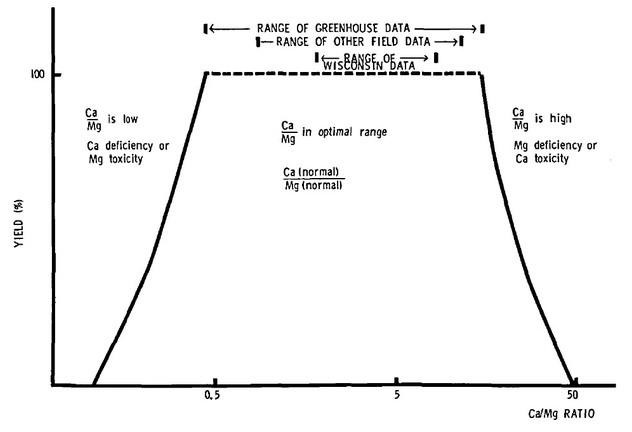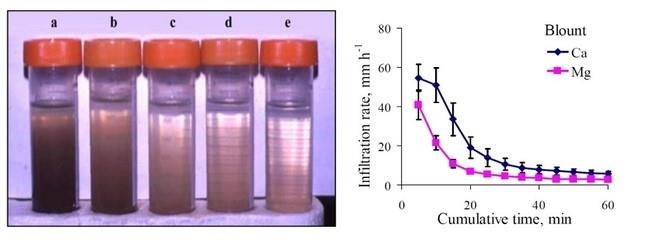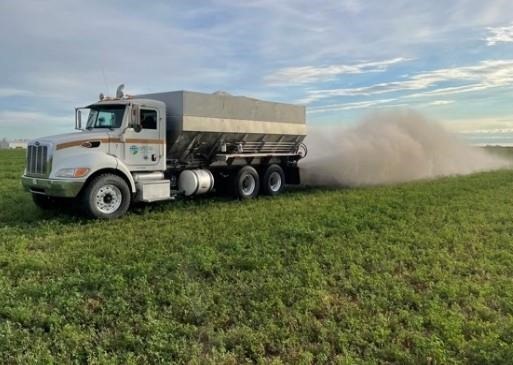By Roland D Meyer and Daniel H. Putnam et.al
DIAGNOSING A FIELD PROBLEM
Can applications of Calcium (Ca) fertilizers improve plant nutrient uptake or improve soil properties in alfalfa fields?
These questions were presented to us by an alfalfa grower in the Sacramento Valley of California where low soil Ca levels were observed.
Soil samples were taken from 9 different alfalfa fields in Yolo County in the fall of 2021 to assess nutrient needs. This farmer had done an excellent job of maintaining P and K levels, but calcium levels were often low: ranging from 1.0 - 4.0 meq/l. Anything less than 4.0 meq/l calcium is considered very low. Were these calcium levels too low and limiting to plant growth and alfalfa yields in these fields?
Ca Nutrient Needs of Alfalfa. Calcium is an essential nutrient for plant growth, one of 17 'essential nutrients' for all plants. Ca is considered a ‘macro-nutrient', that is, an element needed in large quantities. Magnesium (Mg) is also an essential nutrient needed in large quantities. An 8 ton/acre alfalfa crop removes about 256 lbs. of Ca and 53 lbs. Mg per year, so demands for Ca are much greater than for Mg (Meyer et al., 2007). Although the concentration in these soil reports for Ca were low, they are likely still adequate to satisfy the annual crop uptake and removal levels for crop production (although long-term depletion of Ca should be of concern). We have not seen any data that suggests that applications of Calcium correct the nutrient needs of alfalfa to improve yields or that Ca is limiting in California soils, or even nationally.
But that's not the only consideration.
Ca: Mg Ratios. The ratios of Ca to Mg in soils are important because these minerals often compete with each other for uptake by plants. Both are 2+ positive ions (CA++, Mg++). For nutrient deficiencies to occur in alfalfa fields, Ca:Mg soil ratios would need to be very low, around 1:4, or very high in calcareous soils (Figure 1, Simpson et al., 1979).

Figure 1. Range in Ca:Mg ratios over which no yield depression has been observed in alfalfa. Alfalfa is well-adapted to a wide range in Ca:Mg ratio levels (graph from Simson et al. 1979). Ca is rarely observed as a limiting nutrient in alfalfa production.
Fortunately, alfalfa is well-adapted to a wide range of Ca levels, as well as a wide range of Ca:Mg ratios in soils. Alfalfa only showing sensitivity and yield losses at extremely high or low levels of either Ca or Mg (Figure 1). Simpson et al., (1979) concluded that at a neutral pH, alfalfa yields would not be much affected by varying Ca:Mg ratios. In multiple studies, there is a wide range in Ca:Mg ratios over which no yield depression has been observed (Simson et al. 1979). The soil analyses in this Yolo County case revealed that the ratio of Ca:Mg ranged from 0.6-1.3 meq/l (Figure 2), still in the good range to satisfy the plant needs for calcium (Figure 2).
In general, Yolo County soils tend to have somewhat higher Mg levels due to parent serpentine soils in the coastal mountains. Additional analyses in these soils samples from the nine different fields showed Potassium (K) ranging from 0.3 - 1.3%, Sodium (Na) 0.5 - 2.3%, and Boron (B) 0.7-2.2 ppm. Boron also tends to be higher due to ancient borax deposits in the same watershed.

Figure 2. Range of Ca:Mg ratios reported in the soil analysis for 9 alfalfa fields (some sampled twice) in Yolo County in 2021. These are within the range for no yield losses associated with production (Figure 1).
SOIL PROPERTIES AND SOIL HEALTH
However, that's not the whole story. It's also important to look at soil properties (‘soil health'). These are factors such as aeration, crusting, compaction, organic matter, and water infiltration. The ratio of Ca to Mg may also affect water infiltration rates, crusting, and soil losses on specific soils that are prone to sealing (Dontsova and Norton, 2001). Figure 3 shows the effect of either high Mg or high Ca on flocculation of soils and water infiltration from their work. These researchers found that in well-structured soils, Ca-treated soils had infiltration rates double that of Mg-treated soils (Dontsova and Norton, 2001). Ca-treated soils reduced suspension and soil erosion losses, which under irrigation could reduce erosion and particle contamination of surface waters.

Figure 3. High Calcium ratios (a-e range from 0:100 to 100:0 Ca:Mg ratio, left) improves flocculation, reduces soil suspension (left photo). High Calcium also significantly improved infiltration rates. (Data from Dontsova and Norton, 2001). Flocculation improves water infiltration and prevents runoff due to development of larger macro-pores. Blount is a specific soil type.
So additions of high Ca containing amendments (such as gypsum) could have profound affects on soil quality and health.
These soil properties may be more important than the quantity of Ca available for plant nutrition. High Ca:Mg ratios may improve surface water infiltration, reduce runoff and improve aeration. It's also well known that additions of gypsum (Calcium Sulfate or CaSO4) improves soil water infiltration due to the replacement of sodium (Na) with Ca on soil particles. Although these Yolo soils are not particularly high in sodium, the addition of gypsum may also serve to improve water infiltration and soil properties due to improved Ca:Mg ratios as well as replacing the Na on the soil coloids.
No Ideal Ratio. Although some labs and agronomists have promoted an 'ideal' ratio of Ca:Mg (and K), review of the data has shown that, although high Ca is important, there is really no ideal ratio of these cations that improve plant growth or soil properties (Kopittke and Menzies, 2007).
SUMMARY
Addition of gypsum is highly recommended to improve soil properties on these soils, but not necessarily to improve Ca nutrition for alfalfa. Ca concentrations and Ca:Mg ratios are in a good range for alfalfa production in these Yolo County alfalfa fields sampled, and we are are not aware of data that indicates Ca as a major limiting factor for plant growth or Ca uptake. But additions of Ca-rich amendments are likely to positively impact soil quality (improved water infiltration, reduced crusting), which in turn, could improve yields. Low Ca:Mg ratios may cause crusting of soils after rain or irrigation events, cause excess runoff, and poor water infiltration. This is important for agriculture but also environmentally, since off-site movement of particulates are a problem for soil erosion and contamination of surface waters with soil (and pesticides attached to soils!). These infiltration issues are primarily a problem in the top ¼ to 1” of soil, thus surface application is recommended vs. incorporation. For soils with less than 1:1 ratio of Ca:Mg, a recommendation would be to apply gypsum at 2 tons per acre or greater on the soil surface for existing stands to improve water infiltration, prevent soil erosion and runoff and surface water pollution. This is also important during stand establishment just after seeding the alfalfa fields to help prevent crusting of the soil, ensuring good seedling emergence and stand establishment.

Photo: Gypsum being applied to an alfalfa field in Yolo County at 3 tons/ac in the fall of 2021 to evaluate impacts on calcium levels in the soil in a UC Cooperative Extension trial.
Additional Notes on Soil Sampling: A number of different soil tests can be used to evaluate calcium and magnesium concentrations in soil. One of the more common is using the cation exchange capacity or (CEC). This is usually expressed in terms of milliequivalents per 100 grams soil or meq/100g soil. Soil tests will usually give the concentrations of calcium (Ca), magnesium (Mg), potassium (K) and sodium (Na). These represent the more important cations in the soil that characterize both soil and plant growing conditions for favorable plant growth.
- Calcium:Consider the Ca concentration as a percentage of the total cation exchange capacity (CEC). For good soils and plant growth, it should be in the range of 55% ± 5% of the CEC. Higher than 70-75% Ca, then the magnesium (Mg) should be around 20% or slightly higher for good balance. If it is much higher, say 40-50% magnesium, then there may be crusting of soils following a rain or irrigation and poor water infiltration. Increasing the percentage of calcium concentration or decreasing the magnesium concentration requires large amounts of gypsum or other sources of calcium to alter the percentage of calcium.
- Magnesium: Having set the calcium concentration, we will move on to magnesium. The magnesium concentration should always be less than the calcium concentration, perhaps 20-40% of the total cation exchange capacity (CEC)
- Potassium: A favorable range of potassium in soils is usually about 2% of the CEC or less. Adequate concentrations are usually given in ppm of exchangeable K at about 100 ppm to 150 ppm or above.
- Sodium: Since sodium is not an essential nutrient for plant growth, the need for sodium in the soil is minimal, as near to zero as possible.
Source : ucanr.edu